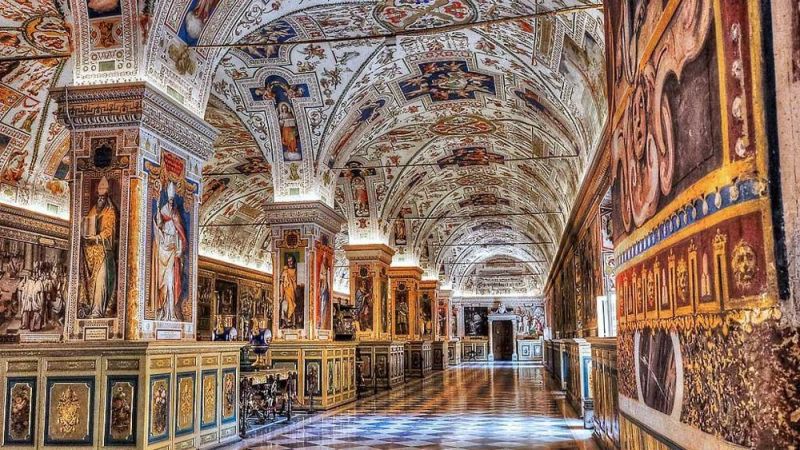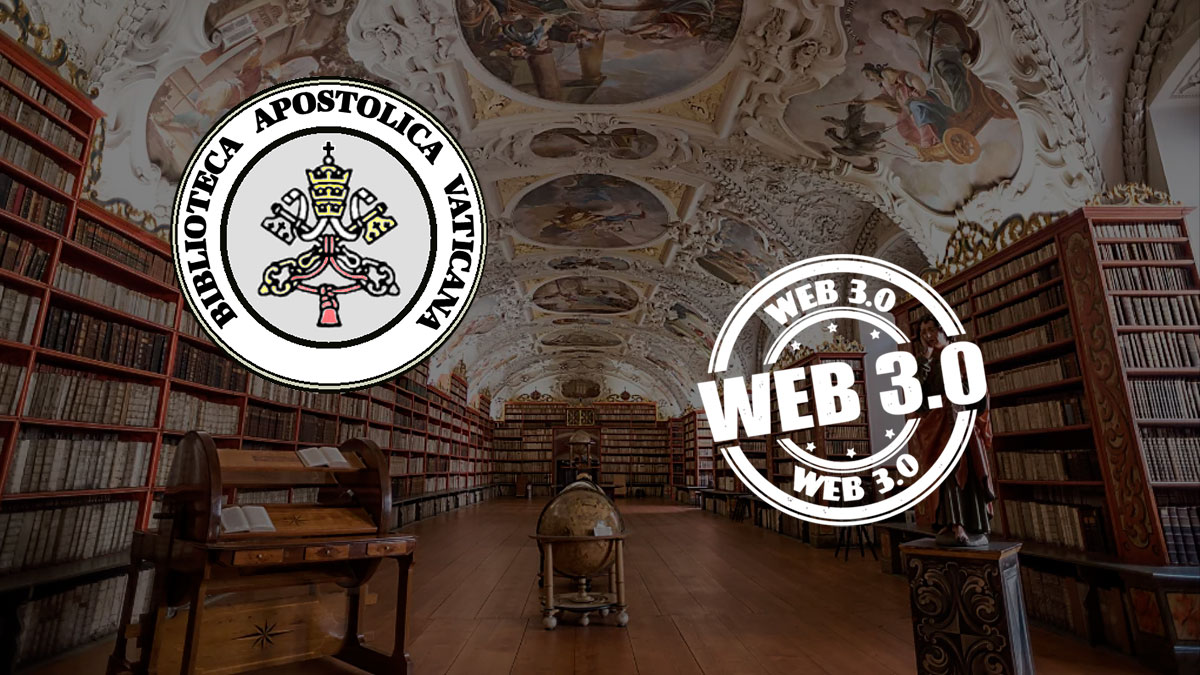Vatican NFT Project
 In a groundbreaking initiative that fuses the age-old heritage of the Catholic Church with cutting-edge technology, the Vatican has ventured into the world of Non-Fungible Tokens (NFTs). This move, which might seem surprising to some, underscores the Vatican's willingness to embrace new methods to share its rich cultural, artistic, and historical patrimony with a global audience. The Vatican NFT Project represents a harmonious blend of tradition and innovation, creating a digital bridge between the past and the future.
In a groundbreaking initiative that fuses the age-old heritage of the Catholic Church with cutting-edge technology, the Vatican has ventured into the world of Non-Fungible Tokens (NFTs). This move, which might seem surprising to some, underscores the Vatican's willingness to embrace new methods to share its rich cultural, artistic, and historical patrimony with a global audience. The Vatican NFT Project represents a harmonious blend of tradition and innovation, creating a digital bridge between the past and the future.
A Brief Overview on NFTs
Non-Fungible Tokens, or NFTs, are a type of digital asset that represent ownership or proof of authenticity of a unique item or piece of content, often linked to digital art, music, videos, and other forms of media. Unlike cryptocurrencies such as Bitcoin or Ethereum, which are fungible and can be exchanged on a one-to-one basis, NFTs are unique and cannot be replaced with something else. Each NFT is distinct and is stored on a blockchain, which ensures its provenance and authenticity.
The NFT market has exploded in recent years, driven by the desire for digital ownership and the unique benefits blockchain technology offers. Artists, musicians, and creators of all kinds have embraced NFTs as a way to monetize their work and connect directly with their audiences. Now, the Vatican is leveraging this technology to open new doors for cultural engagement.
The Vision Behind the Vatican NFT Project
The Vatican's foray into the NFT space is part of a broader vision to modernize its outreach and preserve its extensive collection of art, manuscripts, and historical artifacts. The Vatican Museums house some of the most renowned artworks in the world, including masterpieces by Michelangelo, Raphael, and Leonardo da Vinci. These treasures, however, are often confined within the Vatican's walls, accessible only to those who can visit in person.
The Vatican NFT Project aims to democratize access to these cultural treasures, allowing people from all corners of the globe to experience and own a piece of the Vatican's history in a digital format. By creating NFTs of select artworks and artifacts, the Vatican can share its heritage with a wider audience, fostering a deeper appreciation for the Catholic Church's contributions to art and culture.
Key Features and Offerings of the Vatican NFT Project

- Digitization of Artworks and Artifacts: The Vatican has embarked on an ambitious project to digitize its extensive collection. High-resolution images and 3D scans of paintings, sculptures, manuscripts, and other artifacts are being created to capture every detail of these works. These digital representations form the basis of the NFTs, ensuring that each token is a faithful and high-quality reproduction of the original.
- Limited Edition NFTs: To maintain the exclusivity and value of the NFTs, the Vatican is releasing them as limited editions. Each NFT is unique and will be accompanied by a certificate of authenticity, which guarantees its provenance and connection to the Vatican's collection. This approach not only enhances the value of the NFTs but also aligns with the Vatican's tradition of valuing rarity and uniqueness in its artifacts.
- Virtual Exhibitions: The Vatican is creating virtual exhibitions that allow NFT owners and the general public to explore its collection in a digital space. These virtual galleries offer an immersive experience, with interactive features that provide detailed information about each artwork and artifact. Users can navigate through the galleries, zoom in on specific pieces, and learn about their history and significance.
- Augmented Reality Experiences: In addition to virtual exhibitions, the Vatican is leveraging augmented reality (AR) technology to enhance the experience of owning an NFT. By using AR, NFT owners can project digital artworks into their physical space, creating a seamless blend of the virtual and real worlds. This technology brings the Vatican's collection to life in new and exciting ways, allowing users to interact with and appreciate the artworks in their own environment.
- Charitable Initiatives: True to its mission of service and charity, the Vatican is using a portion of the proceeds from NFT sales to support various charitable causes. These initiatives include funding for education, healthcare, and humanitarian projects around the world. By purchasing an NFT, buyers not only acquire a unique digital asset but also contribute to the Vatican's efforts to make a positive impact on society.
The Impact on the Art World and Cultural Heritage
 The Vatican NFT Project has significant implications for the art world and the preservation of cultural heritage. By digitizing and tokenizing its collection, the Vatican is setting a precedent for how cultural institutions can leverage technology to safeguard and share their treasures. This project highlights several key benefits:
The Vatican NFT Project has significant implications for the art world and the preservation of cultural heritage. By digitizing and tokenizing its collection, the Vatican is setting a precedent for how cultural institutions can leverage technology to safeguard and share their treasures. This project highlights several key benefits:
Increased Accessibility: NFTs make it possible for people who may never have the opportunity to visit the Vatican in person to experience its collection. Digital ownership transcends geographical barriers, enabling a global audience to engage with and appreciate the Vatican's art and history.
Preservation of Artworks: Digitization serves as a form of preservation, ensuring that high-quality digital copies of artworks and artifacts are available for future generations. This is particularly important for fragile or deteriorating pieces that may be at risk of damage or loss over time.
New Revenue Streams: The sale of NFTs provides the Vatican with a new source of revenue, which can be reinvested in the maintenance and conservation of its collection. This financial support is crucial for sustaining the Vatican's cultural and educational initiatives.
Educational Opportunities: The Vatican NFT Project offers educational opportunities by providing detailed information and context for each digitized piece. Virtual exhibitions and AR experiences can be used as teaching tools in classrooms and academic institutions, enriching the study of art history and cultural heritage.
Challenges and Considerations
While the Vatican NFT Project holds great promise, it also faces several challenges and considerations:
Technological Barriers: The implementation of NFTs and blockchain technology requires significant technological infrastructure and expertise. Ensuring the security and integrity of the digital assets is paramount, as is the need to protect against potential cyber threats.
Environmental Concerns: The environmental impact of blockchain technology, particularly the energy consumption associated with minting NFTs, has been a subject of debate. The Vatican will need to consider sustainable practices and potentially explore eco-friendly blockchain solutions to address these concerns.
Ethical Implications: The commercialization of cultural heritage through NFTs raises ethical questions about ownership and access. The Vatican must navigate these complexities thoughtfully, ensuring that its approach aligns with its values and mission.
Market Volatility: The NFT market is relatively new and can be volatile. The Vatican will need to carefully manage its NFT offerings to ensure stability and avoid potential pitfalls associated with market fluctuations.
Future Directions and Innovations
The Vatican NFT Project is just the beginning of what could be a broader adoption of digital technology within the Vatican and other cultural institutions. Looking ahead, several exciting possibilities could further enhance the project:
- The Vatican could collaborate with contemporary artists to create new works inspired by its collection. These collaborations could result in unique NFTs that blend traditional and modern artistic styles, attracting a diverse audience of art enthusiasts.
- Building on the success of virtual exhibitions, the Vatican could develop interactive educational platforms that offer in-depth courses on art history, theology, and cultural studies. These platforms could feature exclusive NFT content, providing a valuable resource for students and researchers.
- The Vatican could partner with other museums and cultural institutions around the world to create a global network of digital cultural exchanges. By sharing digitized collections and NFT offerings, these institutions can foster cross-cultural understanding and appreciation.
- The revenue generated from NFT sales could be reinvested in advanced conservation techniques, ensuring the long-term preservation of the Vatican's collection. This includes the use of cutting-edge technology to monitor and protect artworks from environmental and structural damage.
Conclusion
 The Vatican NFT Project represents a bold and innovative step into the digital age, demonstrating the Vatican's commitment to preserving and sharing its cultural heritage in new and exciting ways. By embracing NFTs, the Vatican is not only democratizing access to its collection but also setting a precedent for how cultural institutions can leverage technology to enhance their outreach and impact.
The Vatican NFT Project represents a bold and innovative step into the digital age, demonstrating the Vatican's commitment to preserving and sharing its cultural heritage in new and exciting ways. By embracing NFTs, the Vatican is not only democratizing access to its collection but also setting a precedent for how cultural institutions can leverage technology to enhance their outreach and impact.
As the project continues to evolve, it will undoubtedly inspire other institutions to explore the potential of NFTs and digital technology. The Vatican's approach, characterized by a blend of tradition and innovation, serves as a model for how to navigate the complexities and opportunities of the digital era.
Ultimately, the Vatican NFT Project is more than just a technological endeavor; it is a testament to the enduring value of art and culture, and a reminder of the power of innovation to connect us with our shared human heritage.





































